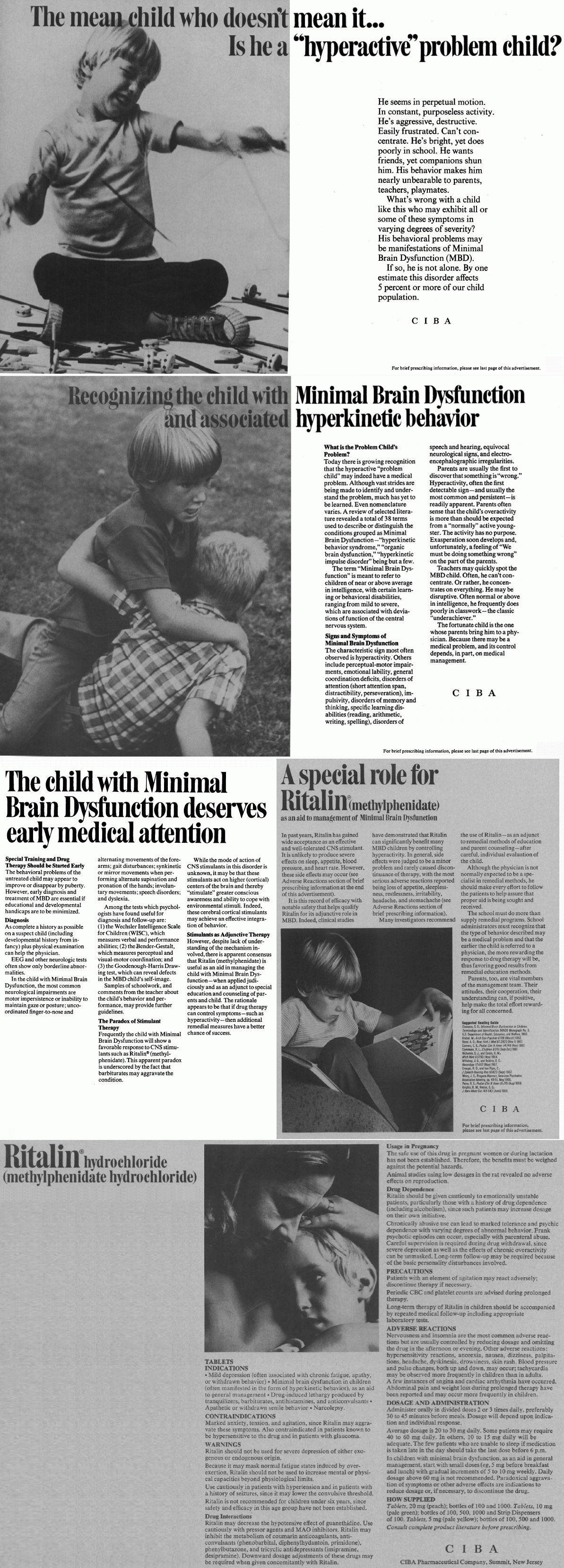

|
|
7-page Ritalin advertisement, 1970. American Journal of Diseases of Children, Vol. 120, No. 3, pp. 50-56. The mean child who doesn't mean it... Is he a "hyperactive" problem child? He seems in perpetual motion. In constant, purposeless activity. He's aggressive, destructive. Easily frustrated. Can't concentrate. He's bright, yet does poorly in school. He wants friends, yet companions shun him. His behavior makes him nearly unbearable to parents, teachers, playmates. What's wrong with a child like this who may exhibit all or some of these symptoms in varying degrees of severity? His behavioral problems may be manifestations of Minimal Brain Dysfunction (MBD). If so, he is not alone. By one estimate this disorder affects 5 percent or more of our child population. Recognizing the child with Minimal Brain Dysfunction and associated hyperkinetic behavior What is the Problem Child's Problem? ~ Today there is growing recognition that the hyperactive "problem child" may indeed have a medical problem. Although vast strides are being made to identify and understand the problem, much has yet to be learned. Even nomenclature varies. A review of selected literature revealed a total of 38 terms used to describe or distinguish the conditions grouped as Minimal Brain Dysfunction -- "hyperkinetic behavior syndrome," "organic brain dysfunction," "hyperkinetic impulse disorder" being but a few. The term "Minimal Brain Dysfunction" is meant to refer to children of near or above average in intelligence, with certain learning or behavioral disabilities, ranging from mild to severe, which are associated with deviations of function of the central nervous system. Signs and Symptoms of Minimal Brain Dysfunction ~ Parents are usually the first to discover that something is "wrong." Hyperactivity, often the first detectable sign -- and usually the most common and persistent -- is readily apparent. Parents often sense that the child's overactivity is more than should be expected from a "normally" active youngster. The activity has no purpose. Exasperation soon develops and, unfortunately, a feeling of "We must be doing something wrong" on the part of the parents. Teachers may quickly spot the MBD child. Often, he can't concentrate. Or rather, he concentrates on everything. He may be disruptive. Often normal or above in intelligence, he frequently does poorly in classwork -- the classic "underachiever." The fortunate child is the one whose parents bring him to a physician. Because there may be a medical problem, and its control depends, in part, on medical management. The child with Minimal Brain Dysfunction deserves early medical attention Special Training and Drug Therapy Should be Started Early ~ The behavioral problems of the untreated child may appear to improve or disappear by puberty. However, early diagnosis and treatment of MBD are essential if educational and developmental handicaps are to be minimized. Diagnosis As complete a history as possible on a suspect child (including developmental history from infancy" plus physical examination can help the physician. EEG and other neurologic tests often show only borderline abnormalities. In the child with Minimal Brain Dysfunction, the most common neurological impairments are motor impersistence or inability to maintain gaze or posture; uncoordinated finger-to-nose and alternating movements of the forearms; gait disturbances; synkinetic or mirror movements when performing alternate supination and pronation of the hands; involuntary movements; speech disorders; and dyslexia. Among the tests which psychologists have found useful for diagnosis and follow-up are: (1) the Wechsler Intelligence Scale for Children (WISC), which measures verbal and performance abilities; (2) the Bender-Gestalt, which measures perceptual and visual-motor coordination; and (3) the Goodenough-Harris Drawing test, which can reveal defects in the MBD child's self-image. Samples of schoolwork, and comments from the teacher about the child's behavior and performance, may provide further guidelines. The Paradox of Stimulant Therapy ~ Frequently the child with Minimal Brain Dysfunction will show a favorable response to CNS stimulants such as Ritalin® (methylphenidate). This apparent paradox is underscored by the fact that barbiturates may aggravate the condition. While the mode of action of CNS stimulants in this disorder is unknown, it may be that these stimulants act on higher (cortical) centers of the brain and thereby "stimulate" greater conscious awareness and ability to cope with environmental stimuli. Indeed, these cerebral cortical stimulants may achieve an effective integration of behavior. Stimulants as Adjunctive Therapy However, despite lack of understanding of the mechanism involved, there is apparent consensus that Ritalin (methylphenidate) is useful as an aid in managing the child with Minimal Brain Dysfunction -- when applied judiciously and as an adjunct to special education and counseling of parents and child. The rationale appears to be that if drug therapy can control symptoms -- such as hyperactivity -- then additional remedial measures have a better chance of success. A special role for Ritalin® (methylphenidate) as an aid to management of Minimal Brain Dysfunction In past years, Ritalin has gained wide acceptance as an effective and well-tolerated CNS stimulant... Many investigators recommend the use of Ritalin -- as an adjunct to remedial methods of education and parent counseling -- after careful, individual evaluation of the child. Although the physician is not normally expected to be a specialist in remedial methods, he should make every effort to follow the patients to help assure that proper aid is being sought and received. The school must do more than supply remedial programs. School administrators must recognize that the type of behavior described may be a medical problem and that the earlier the child is referred to a physician, the more rewarding the response to drug therapy will be, thus favoring good results from remedial education methods. Parents, too, are vital members of the management team. Their attitudes, their cooperation, their understanding can, if positive, help make the total effort rewarding for all concerned. For brief prescribing information, please see last page of this advertisement. Consult complete product literature before prescribing. CIBA Pharmaceutical Company, Summit, New Jersey |